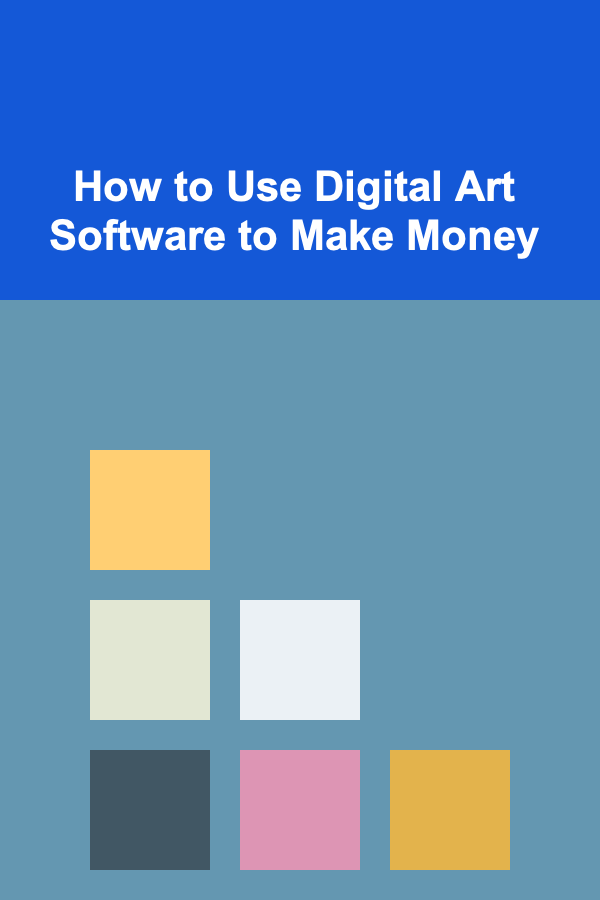
How to Use Digital Art Software to Make Money
ebook include PDF & Audio bundle (Micro Guide)
$12.99$7.99
Limited Time Offer! Order within the next:

In the age of technology and digital creativity, digital art has become a powerful medium for both artistic expression and entrepreneurship. With the rise of social media platforms, online marketplaces, and freelance opportunities, digital art has opened new doors for artists to monetize their work in ways that were once unimaginable. Whether you are a seasoned professional or an aspiring artist, learning how to use digital art software to make money can be an incredibly rewarding venture.
In this article, we will explore the various methods and strategies that digital artists can use to generate income through their skills. We will discuss the essential tools and software, the different monetization opportunities available, and the strategies to build a successful career in the digital art industry.
Choosing the Right Digital Art Software
Before diving into the methods of making money, it's crucial to start with the right tools. The software you choose will shape the way you create, and different programs cater to different styles and needs. Here are some of the most popular digital art software tools used by professionals and hobbyists alike:
Adobe Photoshop
Adobe Photoshop remains one of the most popular digital art tools used by professional artists, illustrators, and designers. It offers a wide range of features, including advanced brush tools, powerful color correction options, and the ability to work with layers. Photoshop is excellent for creating detailed illustrations, digital painting, and photo manipulation.
Procreate
Procreate is a favorite among iPad users, thanks to its intuitive interface and powerful features. It allows for a smooth, natural drawing experience with an extensive library of brushes and tools. Procreate is especially popular among illustrators, comic artists, and concept artists due to its versatility.
Corel Painter
Corel Painter is another powerful digital painting software designed for artists who want a traditional painting experience on a digital canvas. Its brushes simulate real-world media such as oil paints, watercolors, and pastels, making it a favorite for digital artists who aim for a more traditional art style.
Clip Studio Paint
Clip Studio Paint is a comprehensive digital art software that caters to manga and comic artists. It offers advanced tools for line drawing, inking, and creating comic book layouts. Clip Studio Paint is also excellent for animators who wish to create digital animations.
Krita
Krita is a free, open-source digital painting software that has gained a lot of popularity among both beginners and professionals. It is highly customizable and provides many of the features seen in other premium software, making it a fantastic option for artists on a budget.
Choosing the right digital art software depends on your artistic style, the type of work you do, and your preferences regarding tools and user interface. Experiment with a few of these programs to determine which one best suits your creative needs.
Building a Portfolio
Before you can start making money with digital art, you need to have a portfolio that showcases your best work. A portfolio is an essential tool for attracting clients, gaining freelance opportunities, and selling your art.
Create a Website or Portfolio
Having a personal website or portfolio is one of the most effective ways to present your work to potential buyers and clients. Platforms like WordPress, Wix, and Squarespace offer easy-to-use templates that allow you to create a professional-looking website without the need for coding skills.
On your portfolio, make sure to:
- Showcase your best work: Select a few pieces that demonstrate your skills, versatility, and unique style.
- Highlight your expertise: Include a short bio that explains your artistic journey, influences, and specialties.
- Provide contact details: Make it easy for potential clients to reach you for commissions or collaborations.
Use Online Portfolio Platforms
In addition to a personal website, online portfolio platforms like Behance, DeviantArt, and Dribbble can help you gain visibility. These platforms allow artists to upload their work, connect with other creatives, and gain exposure to a wider audience. Many businesses and individuals browse these sites to find freelance artists, so building a presence on these platforms can increase your chances of landing paid opportunities.
Monetization Opportunities for Digital Artists
There are numerous ways digital artists can monetize their skills, and many of these methods allow artists to work independently and retain creative control. Below are some of the most popular and effective ways to make money using digital art software:
Freelance Work and Commissions
One of the most direct ways to earn money as a digital artist is through freelance work and commissions. Many people seek out custom digital art for personal projects, gifts, branding, social media, and more. Freelance platforms such as Fiverr, Upwork, and Freelancer offer a marketplace for artists to find clients who need digital art services.
Here are some common freelance opportunities for digital artists:
- Custom Illustrations: Create one-of-a-kind illustrations for clients based on their specific requirements.
- Character Design: Many companies and game developers seek artists to design characters for their projects.
- Logo Design: Businesses often need logos for branding purposes, and digital artists can offer logo design services.
- Social Media Graphics: Companies and influencers often need custom graphics for social media profiles, posts, and advertisements.
- Album Art: Musicians may seek custom digital art for album covers and promotional materials.
Selling Digital Products
Another excellent way to make money as a digital artist is by creating and selling digital products. Once you create a digital asset, such as an illustration, it can be sold repeatedly without the need for physical production or shipping. Here are some popular digital products that artists can create and sell:
- Prints and Posters: Create high-resolution digital art that can be printed on demand and sold through platforms like Etsy, Redbubble, or Society6.
- Brushes and Textures: Many digital artists sell custom brushes, textures, and other assets that can be used by other artists in their own work.
- Stock Art: Create illustrations, icons, and designs that can be licensed as stock art for use in commercial projects. Websites like Adobe Stock and Shutterstock allow artists to upload their work and earn royalties when their art is downloaded or licensed.
- Digital Wallpapers: Create wallpapers for desktops and mobile devices and sell them on your website or through digital marketplaces.
- Fonts and Typography: If you have a talent for lettering or typography, you can create and sell fonts to other designers and creatives.
Teaching and Tutorials
If you have experience with digital art software and techniques, you can make money by teaching others. Many aspiring artists are eager to learn, and there is a large market for online art courses, tutorials, and workshops.
- Create an Online Course: Platforms like Skillshare, Udemy, and Teachable allow you to create and sell art courses. You can teach anything from beginner digital painting techniques to advanced Photoshop tutorials.
- Offer Private Lessons: If you prefer a more personalized approach, you can offer one-on-one lessons through platforms like Zoom or Skype.
- Create YouTube Tutorials: Many successful digital artists monetize their YouTube channels by posting free tutorials and earning revenue from ads, sponsorships, and merchandise sales.
Crowdfunding and Patreon
Platforms like Patreon and Ko-fi allow artists to receive ongoing support from their fans and followers. Through these platforms, artists can offer exclusive content, behind-the-scenes access, and other perks to their subscribers in exchange for financial support.
- Patreon: By setting up a Patreon account, you can offer different subscription tiers that give supporters access to exclusive art, tutorials, live streams, and more. This provides a reliable source of income and allows you to engage with your audience on a deeper level.
- Ko-fi: Ko-fi is a platform that allows creators to receive one-time donations or set up membership programs. It's an excellent option for artists who want to earn money without the commitment of regular subscription-based content.
Collaborations with Brands
As your digital art gains popularity, you may be approached by brands looking for collaborations. Many companies, especially in the fashion, gaming, and technology industries, seek out artists to create custom artwork for advertising campaigns, products, or limited-edition merchandise.
- Product Design: Work with companies to design merchandise such as clothing, accessories, or packaging.
- Influencer Collaborations: Collaborate with influencers and brands to create content that promotes their products while showcasing your art.
Building a Personal Brand
In the competitive world of digital art, it's essential to build a strong personal brand. A personal brand helps you stand out, attract clients, and gain recognition within the art community.
Engage with Your Audience
Social media platforms like Instagram, Twitter, and TikTok offer a powerful way to connect with potential clients and showcase your art. Regularly posting your work, engaging with followers, and participating in art challenges can increase your visibility and attract a loyal fanbase.
Create a Unique Style
Having a distinctive artistic style can help you stand out from the crowd. Developing a unique visual language will make your work instantly recognizable and help you carve out your niche in the digital art world.
Network with Other Artists and Creatives
Networking is essential in any industry, and the digital art world is no different. Attend virtual art events, engage with other artists on social media, and collaborate with other creatives to build relationships and gain exposure.
Conclusion
The digital art industry offers vast opportunities for artists to monetize their skills and build a sustainable career. By choosing the right digital art software, building a strong portfolio, and exploring various monetization methods, you can turn your passion for digital art into a profitable venture. Whether through freelance work, selling digital products, teaching, or building a personal brand, the possibilities are endless. As the demand for digital art continues to grow, now is the perfect time to start leveraging your skills and turning your creativity into income.
Reading More From Our Other Websites
- [Personal Care Tips 101] How to Use Lip Balm to Protect Your Lips from Sunburn
- [Personal Finance Management 101] How to Avoid Lifestyle Inflation and Keep Saving
- [Beachcombing Tip 101] Reading the Sand: How to Identify and Collect Interesting Finds as a New Beachcomber
- [Home Renovating 101] How to Finance Home Renovation: Securing Low-Interest Loans and Grants
- [Personal Finance Management 101] How to Utilize Tax Deductions for Homeowners to Save More Money
- [Small Business 101] Top Small Business Resources for Entrepreneurs in 2025
- [Home Maintenance 101] How to Clean a Bathroom: Quick and Effective Cleaning Hacks
- [Home Lighting 101] How to Use Lighting to Make Your Small Space Feel Bigger
- [Screen Printing Tip 101] Color Vibrancy Showdown: Screen Printing vs Heat Transfer Explained
- [Personal Care Tips 101] How to Choose the Best Sunscreen for Sensitive and Allergy-Prone Skin

How to Build a Social Media Strategy for Your Startup
Read More
How To Master Coffee Equipment Maintenance
Read More
How to Plan a Family Nature Walk and Picnic
Read More
How to Scale Your Dropshipping Business by Partnering with Multiple Wholesalers
Read More
How to Train Your Cat to Enjoy Brushing
Read More
How to Build a Custom Metal Lathe Stand
Read MoreOther Products

How to Build a Social Media Strategy for Your Startup
Read More
How To Master Coffee Equipment Maintenance
Read More
How to Plan a Family Nature Walk and Picnic
Read More
How to Scale Your Dropshipping Business by Partnering with Multiple Wholesalers
Read More
How to Train Your Cat to Enjoy Brushing
Read More